Okeanus Science & Technology has announced their role in the success of a deep ocean mining benthic impact experiment (BIE) off the coast of New Zealand.
Conducted by the National Institute of Water and Atmospheric Research (NIWA), Okeanus supported the BIE by refurbishing and providing the Okeanus Benthic Disturber, a unique in situ tool designed to help assess potential impact associated with mining for manganese nodules. During the 28-day cruise, the Okeanus Benthic Disturber was towed on the seafloor in an effort to re-suspend bottom sediment that could be subsequently studied for its potential environmental impact.
“The NIWA BIE was an exciting challenge for the Okeanus team. I am thrilled that we were able to successfully bring the Benthic Disturber back to life after its 20-year hiatus,” said Ted Brockett, CEO of Okeanus. “It was an honor to support the NIWA BIE program and its crucial research.”
Upgrades made to the Benthic Disturber include refurbishment of the fluidizing and sediment lift pumps, and the redesign of the data telemetry and power distribution systems to accommodate deployment using a 1,900-meter UNOLS style 0.681” double armored coax cable. Additionally, Okeanus made modifications to the fixed stabilizing fin on the Benthic Disturber, allowing it to be folded down during initial deployment onto the stern ramp. This modification ensured the NIWA research vessel, R/V Tangaroa, would be able to accommodate the device’s height.
Dr. Malcolm Clark, a principal scientist at NIWA and voyage leader for the survey, commented, “We were very pleased with the efforts Okeanus made to refurbish the Disturber, and modify and configure it for operation off our research vessel.”
Real-time video of the Benthic Disturber discharge showed that sediment was being discharged into the water column. However, subsequent survey of the seafloor did not show significant amounts of redeposited sediment as had been expected. Post cruise analysis is currently underway, but initial thoughts point toward two potential reasons: relatively high near bottom currents dispersing the sediment plume rapidly, and the makeup of the sediment at the shallower (approximately 400-meter depth) NIWA test site being siltier than the very fine sediments found in the abyssal plains of the Clarion Clipperton Fracture Zone. Consideration is being given to potential changes and adjustments to the Benthic Disturber and a subsequent follow-on experiment in the future.
In addition to the Benthic Disturber, Okeanus also provided a DT3060EHLW winch with slip ring and coax cable for the project. Okeanus operates an extensive pool of rental equipment from which this winch was obtained. Learn more about the history of the Okeanus Benthic Disturber here.





